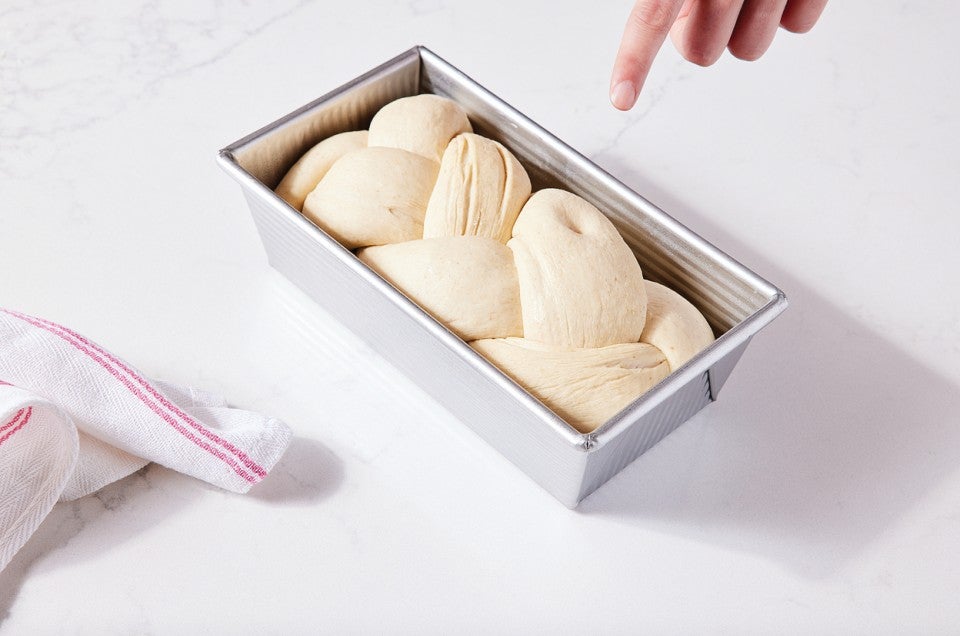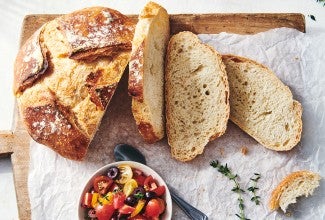


 The bakers of King Arthur are here to solve the kitchen conundrums you share with us, whether it’s on the phone, computer, or by the good old postal service. In Ask the Baker’s Hotline, Annabelle will pick the brains of the talented King Arthur Baker’s Hotline team to tackle some of your most-asked questions.
The bakers of King Arthur are here to solve the kitchen conundrums you share with us, whether it’s on the phone, computer, or by the good old postal service. In Ask the Baker’s Hotline, Annabelle will pick the brains of the talented King Arthur Baker’s Hotline team to tackle some of your most-asked questions.
* * *
Most bread recipes give you a time range for rising, but because kitchen conditions can vary, time isn’t always the best way to measure your dough’s readiness. For instance, if you’re given a rise time of 60 to 90 minutes, should you pull your dough at the front end of that range or later?
Hotline member Maggie is here with all the cues to look for so your next loaf comes out perfectly. Here are her recommendations for nailing your proof:
Bread recipes typically call for two rises: The first is the “bulk” rise when the dough rises in the bowl, while the second rise comes after the dough has been shaped, like when a sandwich dough proofs directly in the loaf pan. “While you have some wiggle room with the first rise, the second rise needs to be more accurate to get a nice full loaf,” Maggie explains. If baked too soon or too late, loaves can collapse and have a dense, gummy center.
“There are so many factors that affect rise time, so exact time will vary for every baker. Things like the water and air temperature, humidity, how large the pieces of dough are, the vessel the dough is in, and how it was shaped will all change the way and the speed that dough rises,” says Maggie. With so many variables in play, think of the times provided in a recipe as a guideline rather than a hard and fast rule. Getting to know the look and feel of proofed dough will be your key to successfully nailing both rises.

For the first rise of the recipe, use a Dough-Rising Bucket with measurements up the side to easily know when your dough has doubled. If you have another straight-sided vessel without measurements up the side, you can use a piece of masking tape to mark the dough’s height when you set it to rest. You’ll be able to clearly see when it has doubled.
For the second rise, many recipes baked in loaf pans will recommend baking once the dough has reached 1” over the lip of the pan. Grab your ruler and check your dough periodically to ensure your dough isn’t under or overproofed. (For accurate results, be sure to use the size of loaf pan listed in your recipe.)

With free-form breads like rolls, pizza crust, or boules, it can be trickier to tell by visuals alone. You can’t gauge rise using the dough’s height over the loaf pan, and if you aren’t a frequent bread baker, it can be tricky to tell if the dough has doubled in volume. While you could measure your shaped dough’s height with a ruler, the dough will be rising outward as well as up, so this is where the poke test can be a better way to gauge readiness.
“Don't be afraid to touch your dough!” Maggie advises. “When ready, it should feel a bit elastic and have some bounce to it, but it shouldn't feel dense or stiff in any way.”
What bakers call the “poke test” is the best way to tell if dough is ready to bake after its second rise. Lightly flour your finger and poke the dough down about 1". If the indent stays, it’s ready to bake. If it pops back out, give it a bit more time.

“If the dough has risen too long, it's going to feel fragile and might even collapse as you poke it,” says Maggie. If this is the case, there’s a chance you can save your dough by giving it a quick re-shape. Learn more about this fix in our blog on saving overproofed dough.
This method works with dough in many forms: pan loaves, free-form loaves, rolls, pizza, and more. Start poke-testing your dough toward the beginning of the rise-time window specified in the recipe. If the temperature and humidity in your kitchen are high, it’s likely your dough will rise faster than you expect. On the flip side, expect longer rise times when the air is cold and dry. Either way, testing early is better than missing your ideal window.
To more easily get the hang of knowing when your dough is ready, it’s helpful to find a recipe you like and stick with it. Maggie shares, “I make one recipe, our No-Knead Crusty White Bread, and tweak it to fit our needs that week. This one dough can become dinner rolls, pizza crust, cinnamon swirl bread, demi baguettes for sandwiches, an olive boule for pasta night, etc. Because I make the dough so frequently, I’ve gotten to know what it feels like when it’s perfectly proofed.”
With more experience, you’ll become better at identifying the sweet spot when your dough is proofed. To really nail things down, take notes on the timing and conditions of your dough that you can refer to next time. Soon you can use these learnings when baking other bread recipes as well.
For a more hands-off approach to mastering the perfect proof, a Folding Bread Proofer creates the ideal environment for your dough to thrive.
Cover photo by Kristin Teig.


